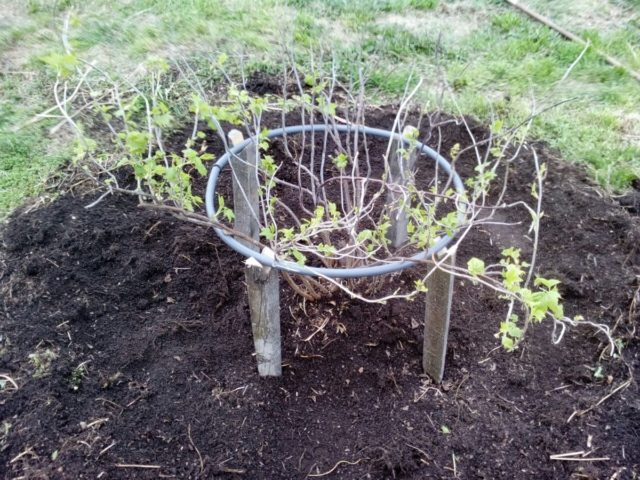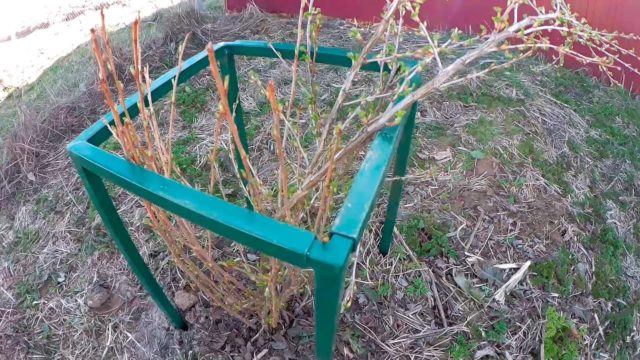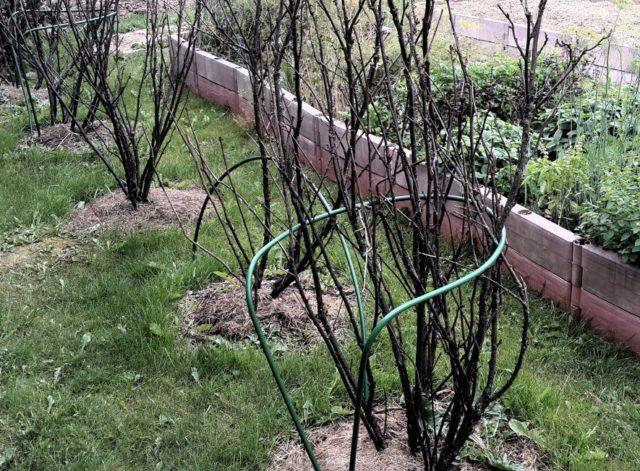Content
Currant bushes are characterized by rather intensive growth of young shoots, and over time, the side branches lean close to the ground or even lie on it. In this case, gardeners say that the bush is falling apart. Meanwhile, the side shoots are still young enough and bear fruit abundantly, so there is no point in cutting them out. It is much more correct to make fences for currants with your own hands, giving the side branches with the help of such a support a vertical position or a position close to it.
Why do you need a stand for currant bushes
Fences for currant bushes are made so that the side shoots do not bend too much to the ground. The flexible shoots of the plant, under their own weight and the weight of the ripening berries, actually lie on the ground, which not only spoils the appearance of the bush, but also creates a number of problems. On such branches, harvesting is difficult, the berries are very dirty due to their proximity to the ground. Air exchange in such shoots is slowed down, high humidity and the proximity of the soil create an increased risk of infection of the currant bush with fungal diseases.
If the side branches are old, they can be cut off. However, this is not always justified, especially in the bushes of red and white currants. These species bear fruit on shoots that can be up to 7-8 years old, so if you cut them off earlier than this time, you can knowingly lose a significant part of the harvest. It is much more correct to install an annular support around the bush, on which the side shoots will rest. Thus, several problems are solved at once:
- Contact of side shoots with the soil is excluded.
- Air exchange is normalized in the lower part of the bush.
- Fruiting shoots are preserved.
- The risk of infection of the currant bush with fungal diseases is reduced, as well as the risk of being damaged by pests living in the upper layer of the soil.
- The appearance of the garden is improved.
There are a wide variety of options for ring supports for currant bushes. Finished products can be purchased at a gardening store, and if desired and the availability of tools, these devices are easy to make with your own hands.
What are fences for currant bushes made of?
To make a fence for currant bushes, you can easily adapt a wide variety of things. Among them:
- wooden slats;
- wire;
- metal pipes, fittings, corners;
- polypropylene or polyethylene pipes;
- metal-plastic pipes.
When choosing a material and a project for the manufacture of a support for currant bushes, gardeners are guided, first of all, by the simplicity of the design, its practicality and minimal installation costs. For some site owners, aesthetics are of paramount importance, and for the sake of the appearance of the garden, they are willing to incur additional costs. In this case, the support for the bushes can be made, for example, from carved wood or wrought iron.
It will look, undoubtedly, more beautiful, but to fulfill its main function, namely to support the side shoots, such a fence will be no better than the one made from an old water pipe.
Types of fences for currants
The simplest support-fence for a currant bush can be made with your own hands from pieces of reinforcement and wire. Three or four rods are evenly driven in around the bush, and then tied with wire, fixing on each post.It is not worth driving in pegs too close to the center of the bush, the fence should support the side shoots, and not pull the bush.
Shrub fences made of wooden posts and slats look more aesthetically pleasing. Usually they are made quadrangular, driving four bars into the ground at the corners and tying them together with wooden planks. The structure is fastened with nails or self-tapping screws. A wooden fence for currant bushes is often made collective if the bushes are planted in a row. You can watch the video for more details:
Often, an old polyethylene or metal-plastic pipe is used to make a fence for currants. Usually such a stand is made in the form of a ring, complementing the structure with 3 or 4 legs made from an old metal pipe. For the convenience of putting on a bush, the structure can be either closed or open.
Trellis may well be used to fix the currant bush. In this case, the shrub is made flatter, removing part of the shoots from opposite sides. The lower remaining shoots are simply tied to the trellis, and the bush itself is fanned out.
For currants grown by the standard method, the fence is not set. In this case, next to the shoot, a wooden stake is driven into the ground, to which a stem is tied.
Requirements for stands for currant bushes
First of all, currant supports should fulfill their direct function - to keep the bush in a compact state and not let the lateral branches fall to the ground. In addition, the devices must have some more qualities.
- Convenience... The design of the stand should not interfere with agrotechnical work in the root zone, watering or spraying, as well as harvesting.
- Mobility... It is good if the support can be quickly removed and put in place. The collapsible stands are undoubtedly more complex, but they are more functional.
- Environmental friendliness... The materials that are used for the manufacture of supports should not harm the currant bush itself or the environment.
- Ease of manufacture... It is good if the support-support can be quickly made or repaired with your own hands.
- Profitability... For the manufacture of the fence, you can use obsolete things or materials, which allows you to save a lot.
- Aesthetics... A competently and beautifully made support for a currant bush can become a real decoration of the garden.
- Durability... The materials used must be resistant to atmospheric moisture, sunlight, high or low temperatures, and the structure itself must serve as long as possible.
- Security... The support structure must not pose a hazard to the gardener, pets or birds.
How to make a currant fence with your own hands
If funds do not allow you to buy a finished product in a store, then the fence stand can be made independently from scrap materials. The following are examples and photos of the most common fences for currant bushes, which you can easily do with your own hands:
Wooden cage... To make such a support with your own hands, you will need wooden bars and planks. Their size depends on the size of the bush. The height and width of the cage are selected in such a way that the angle of deviation of the lateral shoots resting on the fence from the vertical does not exceed 45 °. Four bars are corner posts. Planks are attached to them, which serve as a support for lateral shoots.
Collect the fence as follows. Using self-tapping screws or nails, 3 sides of the cage are mounted on all 4 supports.Then the bush is pulled into a bunch using a regular belt. The fence is put on the side of the currant, after which the boards are attached, forming the 4th side of the cage. After that, the strap that fixes the shoots is removed.
Pipe ring... There are quite a few options for making this kind of products with your own hands. The base of the support is a ring made of a metal-plastic or polyethylene water pipe. Its diameter depends on the size of the bush. A variety of objects can be used as legs: the same pieces of pipes, fittings, thick wire. Most importantly, at the end of the post there should be a hole through which the ring from the main pipe is passed.
Depending on the size of the bush, the legs can be from 1 to 4. For ease of installation, the support ring is often made detachable. A type of such support can be a plastic ring with wooden posts. In this case, the role of the legs is played by wooden bars hammered into the ground along the perimeter of the currant bush. In their upper end, a recess is cut into which a support ring is placed.
The shoots tightly press the ring to the bars, but for reliability it will be better to fix it or make it heavier by passing a metal rod inside or filling it with sand.
For lovers of strong and durable structures, we can recommend making with your own hands a completely metal stand for currant bushes from a corner or profile pipe. This option is suitable for those who know how to handle a welding machine and have locksmith skills.
Structures of this type can be made both all-welded and collapsible. Before use, they must be primed and painted, this will greatly increase their service life.
To make do-it-yourself supports for the currant bush, you can use the recently appeared polypropylene pipes. They are durable, aesthetic and environmentally friendly, while they do not have a high price. For the manufacture of the fence, you will need a polypropylene pipe with a diameter of 40 or 50 mm, as well as 4 corner (two-plane) tees.
You can assemble such a structure using a special soldering iron. If such a device is not available or the structure needs to be made collapsible, then it is preferable to use ordinary self-tapping screws.
A good option for making a support for currants with your own hands is a metal rod. If you bend it in a certain way, in the form of a ring with supporting legs, then such a device will serve as an excellent support for the shrub. The method is good for its simplicity, but good physical fitness is required to bring the plan to life.
A currant bush holder made from a metal rod, pictured below.
The number of possible options for making do-it-yourself fences for currant bushes is much more than described in this article. Human fantasy is truly limitless.
Conclusion
Making fences for currants with your own hands is quite simple, for this there are many different options, for every taste and wallet. Most of them do not require special training and are within the power of people with minimal manual skills. However, despite all the simplicity, installing a fence on currant bushes is an important procedure, and should not be neglected.
















